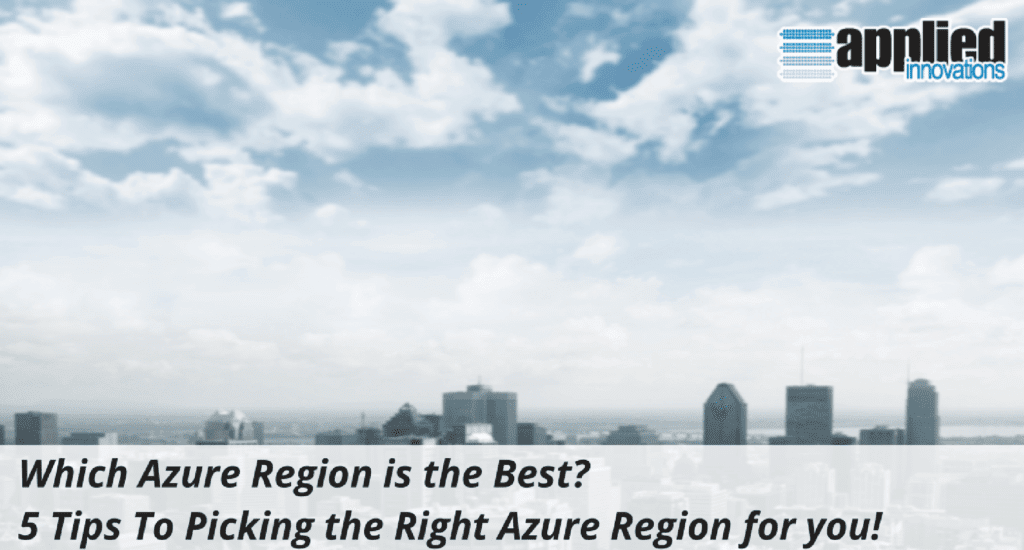When looking at hosting on Azure, the first question you’ll undoubtedly have is which region is the best? The fact of the matter is there are some 26 different regions you can host in Azure and not all regions are equal. Here’s a quick 5 step approach to help you decide which Azure Region is the best for you.
#1) Determine if you have Data Sovereignty issues
Some areas of the world have special rules related to data sovereignty and have to store specific data in specific geographic regions. You’ll want to know if you’re impacted with this first and foremost. For the sake of this article though we’ll assume you’re looking to host in the United States and have no issues with data sovereignty.
#2) Determine Latency to Your Region
Each of these Azure regions will be found in a different geography, and while data travels at the speed of light, there is still latency that occurs. Latency is the time it takes for your information (think your requests, your files, your input, etc.datacenter) to travel from your location to the location in the cloud. At Applied Innovations we strategically picked the NAP of the Americas to host our own cloud because it was so well connected (over 60 different Tier-1 carriers and something like 60% of the traffic routed to Europe passes through our data center.. note these numbers are recollection at the moment and accurate data can be found on the NAP’s website).
With Azure you’ll want to test the latency to the regions you’re interested in to help narrow down the choices. A great tool for this can be found at http://azurespeedtest.azurewebsites.net/. This little site allows you to quickly test latency to several different Azure regions and as you can see from the results below for our office location East US followed by North Central US and South Central US are probably the best for our office connectivity.
If however we’re looking to connect from our datacenter, in the NAP of the Americas, you’ll see that our connectivity changes
Where we have 28 milliseconds of latency to the Azure CDN (that’s because Microsoft has a CDN node in the same datacenter) and sub 100 milliseconds to pretty much all of the US and Canada (again because of the amazing connectivity in our datacenter, see I wasn’t just bragging).
So in my case with solid connectivity to the office and the datacenter I would look at East US, South Central US and North Central US for my regions. Now on to step #3.
#3 What Azure Services Do I Wish To Consume
Next we need to consider what Azure services and what VM sizes I wish to consume in my Azure account as you see not all services and VM sizes are available in all regions. This can quickly be viewed here: https://azure.microsoft.com/en-us/regions/services/ as seen below:
So from that image you can see if I wanted to deploy a Godzilla class VM (G Series was referred to as Godzilla series because of the sheer size at the time of launch with 32 vCPU, 448GB of memory and 6.59TB of local storage (yeah I’m betting your workload would fit in there just fine) but if I needed a Godzilla VM aside from needing nearly $7000/month to run it I’d need to be in either East US 2 or West US. So let’s assume that’s what I want to run and now my datacenter options are restricted to either of those two datacenters. If we go back to the latency it could be a toss up between the two so now on to item #4 of our decision as to where to host our Azure VM.
#4) Location, Location, Location!
Okay, I was going to say “Price, Price, Price” but everyone knows in real estate it’s “Location, Location, Location” and in the case of Azure Location and Price go hand and hand together. Here’s something you probably didn’t realize but some regions in Azure are more expensive than others! Say what?!?! Yep, some regions you’ll pay a premium for the same VM. So let’s fire up the Azure pricing calculator at: https://azure.microsoft.com/en-us/pricing/calculator/ and let’s see what this VM is going to cost me.
In Azure East US 2 my G5 (Godzilla!) is going to cost $6321.60/month according to the calculator:
Yet if we tick the “region” drop down and start to check other regions then we find in West US it’s $6948/month:
And if for some reason we wanted to move that VM over to Japan East region it would only cost $7371.36/month!
#5 Make Smart Choices When Picking Your Azure Regions
So there you have it. Four quick tips to help you pick the best region for your workloads when running on Azure. Now if you think this whole moving to Azure thing is complicated, well you’re right. That’s why Applied Innovations started supporting Azure several years ago before it launched the Azure IaaS offerings and that’s why we’re a great choice to help your business as you start looking for an Azure Consulting Partner and that’s our #5 Tip, go to Azure with Applied Innovations. Feel free to reach out and we’ll be happy to help and if you have your own tips to add please leave them in the comments below. We’re always working to improve our offerings.
